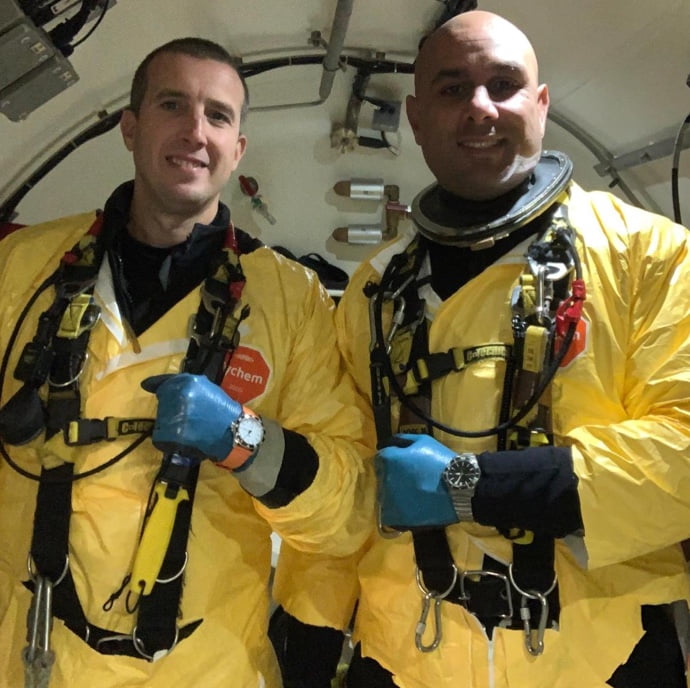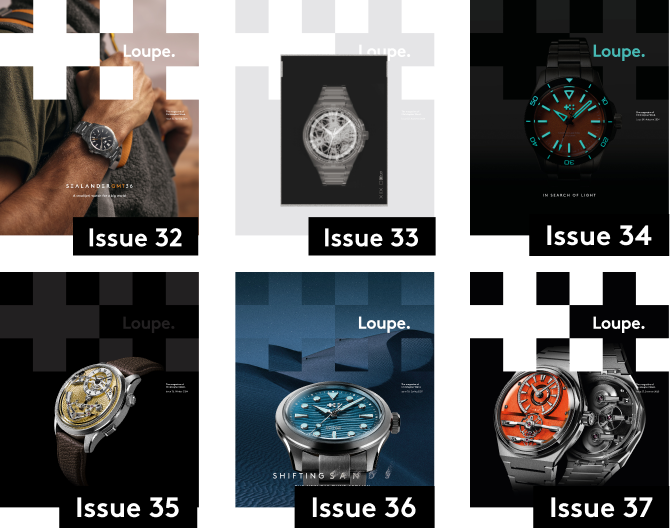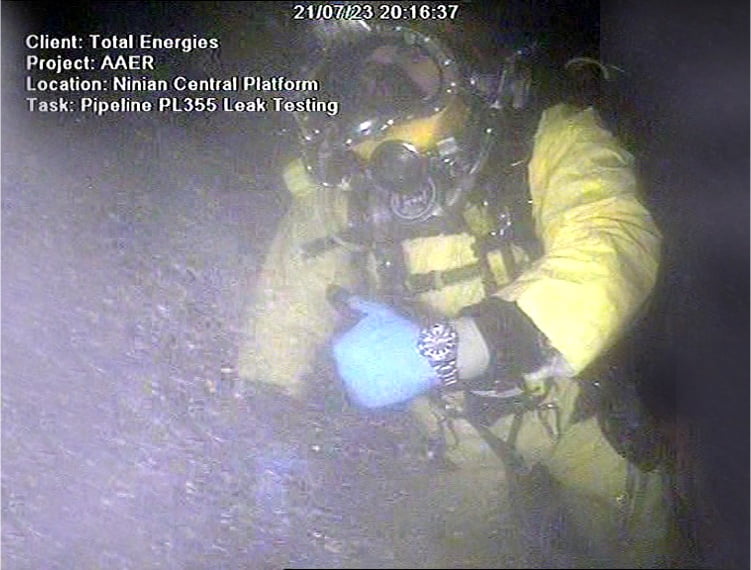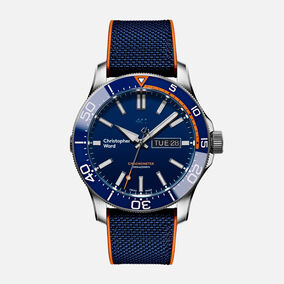What’s it like to work as a commercial diver? In this interview, we talk to one diver about life at the bottom of the ocean, and how a pair of Christopher Ward watches cope with the hostile environment of the North Sea
Deep-sea diving has long been an inspiration to watchmakers. And today, commercial divers still rely on accurate timekeeping to keep them safe. Whether working on oil rigs or salvage operations, working at depth takes its toll mentally and physically on the divers undertaking these vital tasks. David Johnson is a saturation diver – and he’s also a watch fan. So we sent him a C60 Elite 1000 and a C60 Trident Pro 300 to try out at the bottom of the North Sea before speaking to him about life under the ocean.
Hi David! What work have you been doing recently?
Around half the jobs I go on are ‘spool tie-in’ campaigns. A spool is a section of pipe cut to a certain length and shape, and to ‘tie in’ means to join them together. The joints are usually bolted together, but occasionally they have to be welded. When that happens they bring in specialist divers that are also time-served welders.
Over the last five years we’ve worked around the decommissioning oil rigs. This often involves flushing older pipelines with water so any oil left gets washed back up to the rig. Once the pipeline is full of clean water it can be cut into sections and recovered to the surface without any oil escaping into the sea.

Where do you work?
I work on a DSV (dive support vessel). We join it when it comes into port for a crew change or to mobilise equipment at the start of the job. Once we’re onboard, we get our personal dive gear organised, and then there’s a job brief where the project engineer runs through the work with us. Before we enter the saturation chamber we have a medical.
Once we get the ‘OK’ we go to the chamber area. Our vessel has six saturation chambers – all linked – and two diving bells. The chambers have three single beds and a cushioned bench seat where we eat, and there’s also a projector screen. The chamber has a small air lock – a ‘medical lock’ – where we send laundry out and our meals come in.
How is the dive organised?
We dive in teams of three. We get in the chamber and shut the door. The life support supervisor from ‘sat control’ then starts to pressurise the chamber – a process called ‘blowdown’. The chamber is set to the same pressure as the water depth we’ll be working in. It takes one minute per metre to blow down, and the average depth of the North Sea is 90 metres, so it takes about 90 minutes to reach that. Many think we live underwater, but the chamber never leaves the ship.
What about the actual work?
There are four shifts required to cover 24 hours of diving. If you’re on ‘6-6’ days, you cover from 6am to 6pm. On a normal day, you’ll get breakfast sent in at 7am. After breakfast, our dive supervisor gives us a job brief over the chamber comms, and we’re ready to go at 8:30am. As we’re in a team of three, one diver stays in the bell (the ‘bell man’), and two are in the water. We rotate daily, so you do two days diving, then a day as the bell man.

“The Elite is suited for saturation diving due to its helium-release valve”
What happens after?
At 8:30am, the bell man enters the diving bell, which is attached to the chamber via an airlock. He spends 15 minutes checking the gas is flowing to the bell correctly and that the emergency gas will kick automatically if the primary gas supply fails. Once the bell checks are complete, the other two divers enter the bell.
The bell is then sealed off and can safely detach from the chamber. It’s lowered through a hole in the bottom of the ship (the ‘moon pool’) until it’s at the required depth. Once the bottom door is opened, the two divers put on their helmets and leave the bell to start work. The bell man remains in the bell and uncoils the divers’ umbilicals until they have enough slack to reach the worksite.
What equipment do you use?
The two divers have umbilical hoses which supply breathing gas, hot water and power to supply the hats, camera, light and comms. We wear hot-water suits made from 6mm-thick neoprene: hot water is pumped into the suit, where it exits via pierced holes. It’s like having a hot shower in the suit! We also wear a diving helmet, a Kirby Morgan 17, made primarily of fibreglass with a glass faceplate.

Do you have breaks?
Divers can’t do more than six hours, and come back to the bell one at a time for a 15- minute drink break between the third and fourth hours. Six hours later at 3:15pm the team on the 12-24 shift arrive on the bottom in a separate diving bell to replace you. You get back into the diving bell and seal it off. The bell is then raised up back on the ship and is reattached to the chamber. We then have a few hours watching TV and a chance to call home before bed. This cycle repeats every six hours until it’s your turn to dive again.
What about when the dive is over?
We go through a process called decompression where the pressure in the chamber is reduced gradually until it’s at surface pressure and we can leave. For the average 90-metre job it takes just over four days to get out. When I first started saturation diving I remember my bag being full of books, and batteries for my CD Walkman. Now I have an iPad loaded with films!
Does all this affect your body?
The most notable effect saturation diving has on your body is the squeaky voice you get from breathing gas containing helium!

Christopher Ward sent you a C60 Elite 1000 and C60 Trident Pro 300. How did they perform?
I was very impressed! Both performed brilliantly in the environment they were made for. The Elite is more suited for saturation diving due to its helium release valve but the Trident more than held its own, too. And they both look very stylish. There are so many diving watches on the market that claim to be certified to 200 metres, but Christopher Ward definitely walks the walk.
Do you normally wear a watch?
Commercial diving is different to recreational diving as you have a supervisor running your dive. Saying that, the majority of us wear watches in the water. It’s nice to know how long you have got left on your dive even if you can’t do anything about it until the supervisor tells you.
Finally, how does your family cope with you being away?
As hard as it is working away from home and feeling isolated in a chamber, it’s so much easier thanks to my wife, Helen. She’s got a lot going on. Working as my part time secretary, looking after the house/kids while also starting her own travel business: @hjtravel123 on Instagram. I couldn’t manage without her!
The Elite 1000 is available from £1,075/$1,295/€1,395
The Pro 300 is available from £750/$895/€950
Related watches

Sign up to Loupe magazine
Loupe is Christopher Ward’s quarterly in-house magazine. If you want to know what’s happening at CW (and you love great journalism), this is where to start. Alternatively, you can read all our back issues on your computer, tablet or phone.
Order your free copyRead Loupe online



